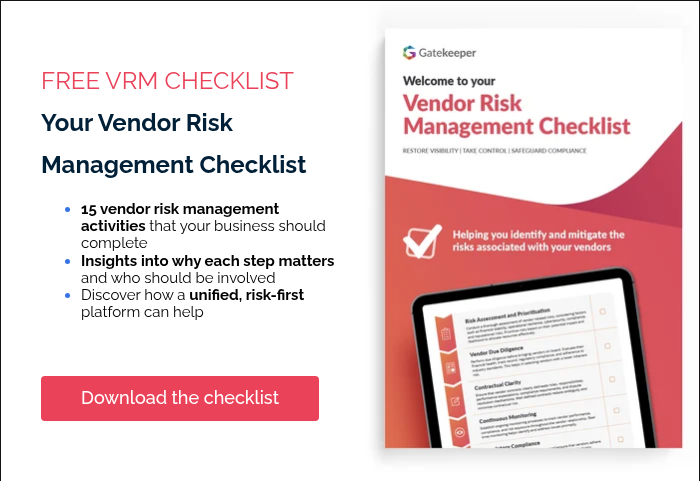Why Do AML and CTF Regulations Matter for Supplier Risk Management?
In both countries, regulators have made it clear: outsourcing AML/CTF functions or sanctions screening doesn't outsource responsibility.
Reporting entities remain fully accountable for the effectiveness of their programs – and that includes oversight of the suppliers, data processors, onboarding platforms, and technology providers they rely on.
In Australia, AUSTRAC guidance is explicit: "If you outsource AML/CTF functions, you remain responsible."
Whether it’s onboarding checks, transaction monitoring platforms, or data verification providers, reporting entities must demonstrate oversight, auditability, and risk-based governance over these relationships.
The New Zealand framework echoes this. While the AML/CFT Act 2009 allows for reliance on third-party agents (section 34), both the FMA and DIA have warned that organisations cannot assume suppliers "take care of it all."
Periodic reviews, sanctions screening, and clear documentation of delegated responsibilities are critical expectations.
Regulators care who helps you comply – not just who you serve.
The Magnified Cost of Third-Party Oversight Failures
Oversight failures in AML/CTF compliance subject mid-market firms to two distinct categories of cost:
1. Immediate, Pre-Enforcement Impact:
These pressures begin when a compliance gap allows a high-risk third-party relationship or activity to proceed. The resulting exposure can create an internal crisis, draining resources and eroding confidence well before any regulatory action is taken.
- Potential Liability Exposure: A compliance gap can expose a firm to the processing or facilitation of illicit funds, creating a potential outflow risk. Under IFRS, for example, such exposures are generally disclosed as contingent liabilities unless probable and measurable, at which point a provision must be recognised.
- Operational Strain: Once detected, existing compliance and legal teams must divert resources to retrospective reviews, investigations, and remediation. These manual interventions consume time and capital, undermining planned growth and margin performance.
- Boardroom Pressure: Directors face heightened scrutiny as they prepare to explain control breakdowns and remediation plans to regulators, auditors, and investors.
2. Eventual, Formal Regulatory Costs
These costs arise once the regulator intervenes – whether AUSTRAC in Australia, or one of New Zealand’s three supervisors (FMA, DIA, or RBNZ, depending on sector).
- Financial Penalties: Recent enforcement actions underline the escalating cost of AML/CTF non-compliance. Westpac was fined A$1.3 billion, the largest penalty in Australian corporate history for systemic failures. And while penalties against mid-market firms are typically smaller, they are often more damaging in proportional terms to leaner balance sheets and reputations.
- Formal Remediation: Enforcement actions often impose enforceable undertakings, independent audits, or mandated reporting programs. These extend and formalise the operational strain already felt internally.
- Reputational Damage: Public announcements of enforcement actions erode stakeholder trust and may trigger customer, investor, and counterparty hesitancy.
From CDD to TPRM: A shift in accountability
This evolution has significant implications for compliance and procurement leaders. Traditional AML/CTF programs focus on customer identification, monitoring, and reporting.
But as these functions increasingly depend on third-party technology and service providers, supplier governance becomes an equally critical control layer.
To satisfy regulator expectations, firms must be able to:
- Demonstrate how third-party suppliers supporting AML/CTF or sanctions compliance are vetted, risk-tiered, and monitored.
- Evidence oversight of sanctions screening tools and data providers integrated into onboarding or procurement workflows.
- Prove that roles, responsibilities, and accountabilities are clearly documented, supported by verifiable audit trails.
Continuous supplier monitoring: Best practice, not box-ticking
Neither AU nor NZ regulations mandate real-time supplier monitoring in the same way they do for customers. However, continuous oversight of third parties is increasingly recognised as a best practice for demonstrating accountability and maintaining regulator confidence.
Gatekeeper was purpose-built for compliance-driven organisations navigating expanding AML/CTF and sanctions accountability.
It unifies the disciplines of third-party risk, contract, and spend management in one continuous platform, giving firms complete control over their external ecosystem.
With Gatekeeper, compliance and procurement leaders can:
- Start Risk-First: Screen every third party before they touch systems or data, embedding sanctions, financial, and governance checks into intake workflows.
- Stay Continuously Compliant: Automate evidence collection, certification renewals, and audit-trail creation, replacing reactive compliance cycles with always-on visibility.
- Connect Contracts to Controls: Ensure every agreement carries the right compliance guardrails, obligations, and renewal triggers - all linked to live supplier data.
- Prove Accountability on Demand: Deliver a single, tamper-evident record regulators can verify instantly, demonstrating proactive oversight rather than box-ticking.
For ANZ firms balancing lean teams with rising regulatory scope, this unified model closes the loop between risk, cost, and control. Compliance becomes a measurable source of resilience and margin protection.
Conclusion
For mid-market firms, the weakest point is often third-party risk. Turning compliance into a strength means building accountability into every external relationship. This shows regulators, investors, and partners that the business is in control.
The future will favour firms that make compliance proactive and efficient - tightening third-party oversight, automating evidence collection, and aligning risk with growth.
Gatekeeper gives compliance-led teams the tools to do exactly that. It unifies third-party, contract, and risk oversight in one platform to keep you always audit-ready.
Book a demo today to see how Gatekeeper can turn compliance from overhead into strategic edge.
Third-Party Oversight in AML/CTF Compliance: Strategic FAQs
1. Why is third-party oversight critical to AML/CTF compliance?
Regulators don’t distinguish between internal teams and outsourced partners when it comes to accountability. Whether it's AUSTRAC or the FMA, your firm remains fully responsible for compliance. Robust third-party oversight ensures external suppliers meet the same governance standards as internal functions - closing the gaps where risk, non-compliance, and enforcement action take root.
2. What are the consequences if a third-party fails to comply with AML/CTF obligations?
The liability remains squarely with the reporting entity. Enforcement penalties, mandated remediation, and reputational damage are common outcomes. Regulatory expectations are clear: firms must maintain a continuous, demonstrable line of oversight - where responsibility doesn’t end at onboarding, but is evidenced throughout the supplier lifecycle.
3. How do AUSTRAC and the FMA treat outsourcing of AML/CTF processes?
They don’t. Outsourcing is not a shield. Both AUSTRAC and the FMA require organisations to retain control, visibility, and demonstrable accountability across every AML/CTF-related process - onboarding, sanctions screening, transaction monitoring, and beyond. Governance must travel with the function, not stop at the contract.
4. What defines best-in-class supplier risk management for AML/CTF?
It starts with risk-based onboarding, continues through periodic reassessment, and is sustained by live, audit-ready monitoring. High-performing teams automate evidence capture, maintain real-time dashboards of risk posture, and track every compliance artefact to the source - ready for regulator or board scrutiny on demand.
5. How does technology reinforce third-party oversight in AML/CTF compliance?
Unified platforms like Gatekeeper integrate contracts, third-party risk, and spend oversight into one live environment. They empower teams to surface risk before exposure, automate due diligence, and centralise control - ensuring no third-party slips through the cracks, no evidence is out of reach, and no audit is a scramble.


.png)
.png)
.png)
-4.png)